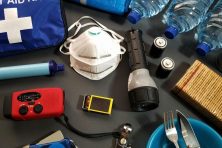Here’s How to Make a Solar Eclipse Viewer or Get Solar Eclipse Glasses

On April 8, 2024, people across the U.S. will be able to witness a total solar eclipse.
Everyone on the vast, 120-mile-wide path reaching from Mexico to Maine will be able to see the complete solar eclipse. Those of us located outside of that pathway will be able to view only a partial eclipse — but that’s still cool!
As people gather to take in the once in a lifetime sight (or maybe twice — the last one occurred back in 2017), it’s important for everyone to remember that staring directly at a solar eclipse is not safe.
If you plan to look directly at it, you’ll need to wear a pair of approved glasses, not regular sunglasses. I’ll let the brains over at NASA explain solar eclipse safety in more detail.
Where to Find Solar Eclipse Glasses
The event will bring with it a lot of intrepid people offering to sell all kinds of merchandise, ranging from souvenirs to parking spaces, and most importantly, eclipse glasses. Be sure you are buying certified glasses from a reputable source, though. Amazon, for example, sells certified eclipse glasses for as little as $5.99 for a pack of 10.
If you’d like to experience the solar eclipse without having to pay for the privilege, you can find solar eclipse glasses in a number of places for free. If you live in an area where the solar eclipse directly passes over, such as New York, community centers and libraries in the area are giving away glasses for free. Certain optometrists, who know better than anyone the effect a solar eclipse can have on the eyes, are also offering free eclipse glasses at specific locations.
But let’s say you can’t reach any of these locations or supplies run out. You can make your own solar eclipse pinhole projector with materials you probably already have in your home.
A pinhole projector is a special tool that allows you to view a shadow, or negative image, of the eclipse without having to look directly at it. This is an especially handy tool if you have children who want to get in on the fun but may not be able to follow the “don’t stare directly at the sun” rules.
Make Your Own Pinhole Projector for the Solar Eclipse

Making your own solar eclipse viewer is simple — which is great because I make it a point to never do a DIY that takes longer to make than the actual event I’m making it for.
(At its longest, the total eclipse will last about 4 minutes and 9 seconds for anyone viewing from the center of the event’s path.)
Here’s how to make your own eclipse viewer.
Materials
1 long or 2 regularly shaped cardboard boxes
Scissors
Duct tape
Knife (for cutting through cardboard)
Aluminum foil
Thumbtack or pin
Sheet of white paper
Build Your DIY Solar Eclipse Viewer
- If you can’t find a long rectangular box, create one out of two smaller boxes. Simply cut the flaps off of one end of each box and use duct tape to connect at the raw edges, forming one long box. (A longer box means a larger projected image.)
- In the middle of the bottom of your box, cut a head-shaped hole.
- Seal the flaps on one end of your box with duct tape. On the inside of this end of the box, tape the sheet of white paper. This will be your “viewing screen.”
- Seal the flaps on the other end of the box. On this end, cut a small rectangle (about 2 inches x 4 inches) a few inches from the top of the box.
- Cut a piece of aluminum foil slightly larger than the rectangle you cut on the box. Make sure the foil stays flat and un-crinkled.
- Tape the piece of foil over the rectangular hole.
- Using a pin or tack, poke a small hole in the center of the foil. Be careful not to rip the foil or make the hole too large.

To view the eclipse, stand outside with the sun directly behind you. Put the eclipse viewer over your head with the pinhole end behind you and the paper end in front of you. Line up the pinhole with the sun until you see the inverted image of the eclipse on the “screen” in front of you.
Once you have your pinhole projector ready, check out the incredibly handy video featured here to find out when the best time to view the solar eclipse where you live will be.
Important note: Looking directly at a solar eclipse — even a partial one — can do lasting damage to your eyesight. Do not attempt to observe the eclipse without proper protective eyewear (meaning special eclipse glasses, not ordinary sunglasses) or a cool tool like this pinhole projector. Always use your pinhole projector correctly, with your back to the sun.
The FTC warns that if you plan to use special eclipse glasses to look directly at the eclipse as it happens, you should make sure the glasses are certified to meet the official international safety standards.
Only wear eclipse viewing glasses that have been approved for use and are new and without scratches, wrinkles or defects. Here is an article with guidelines about what features you should look for in a pair of eclipse viewing glasses.
Grace Schweizer is a former junior writer at The Penny Hoarder. William Fewox contributed to this report.












